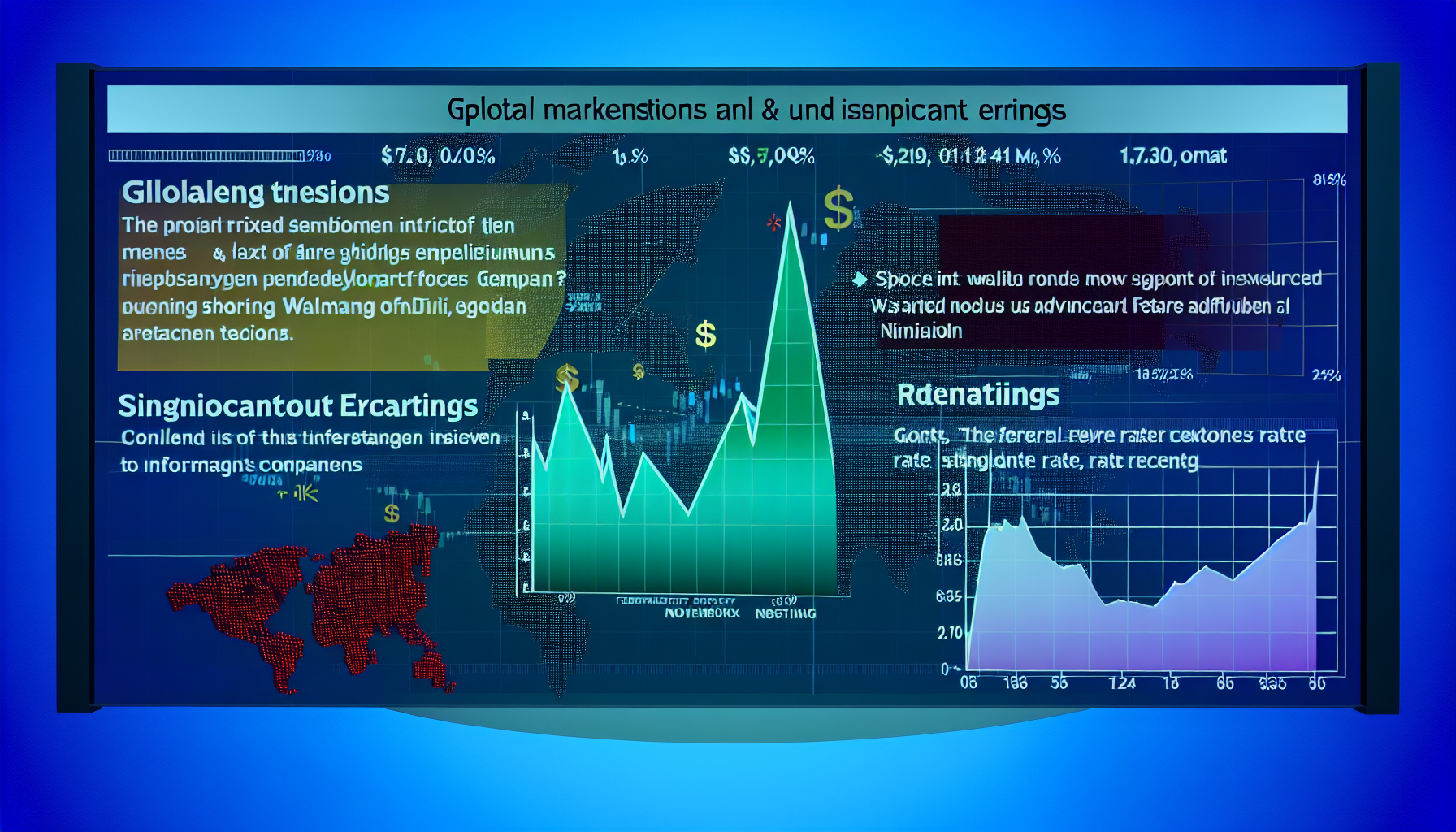
#StockMarketUpdate #EarningsSeason #MarketVolatility
Navigating the Turbulent Waters of the Stock Market: November 19, 2024
As the sun set on another tumultuous day in the stock market, investors found themselves grappling with a mix of positive and negative news that painted a complex picture of the current economic landscape. Here’s a detailed breakdown of the key events and movements that defined the trading day on November 19, 2024.
Mixed Trading and Global Tensions
The day began with U.S. stock futures indicating a positive start, driven by anticipation of key earnings reports from retail giant Walmart ($WMT) and tech behemoth Nvidia ($NVDA)[2].
However, as the trading day unfolded, the markets exhibited mixed behavior. The Dow Jones Industrial Average ($DJIA) dipped by 204 points, or 0.5%, while the S&P 500 remained virtually unchanged after recovering from an early drop of 0.7%. The Nasdaq Composite, on the other hand, managed to flip its losses and end 0.3% higher[1].
The mixed performance was partly influenced by geopolitical tensions. News that Ukraine had fired U.S.-made ATACMS missiles at Russia, coupled with Russian President Vladimir Putin's announcement to lower the threshold for Russia’s use of nuclear weapons, sent jitters through global markets. European indices such as France’s CAC 40 and Germany’s DAX suffered declines of 1% and 1.1%, respectively, reflecting the heightened uncertainty[1].
Safe-Haven Assets and Treasury Yields
In times of geopolitical uncertainty, investors often seek refuge in safe-haven assets. This was evident as U.S. Treasury bonds saw increased demand, leading to a rise in their prices and a subsequent drop in their yields. The 10-year Treasury yield fell to 4.37% from 4.41% the previous day[1].
Earnings Season Spotlight
The earnings season remains a critical focus for investors, and today was no exception. Walmart’s Q3 earnings report was a highlight, with the retail giant impressing investors with its profit figures. This positive news helped stabilize the market and provided some relief amidst the broader volatility[1].
Other companies set to release their quarterly earnings this week include Nvidia, XPeng ($XPEV), Lowe’s ($LOW), Workhorse ($WKHS), and Medtronic ($MDT). These reports will be closely watched as they provide valuable insights into how various sectors are navigating the current economic environment[2].
Sectoral Performance
Sector-wise, the Consumer Discretionary sector saw a boost, partly due to Tesla’s ($TSLA) significant gain of 7.2% on Monday. This surge was driven by reports that President-elect Donald Trump’s transition team is planning to ease U.S. rules for self-driving cars. However, not all tech stocks fared well; Nvidia’s shares declined 1.3% due to concerns over overheating issues with its new AI chips[3].
Healthcare stocks, such as UnitedHealth ($UNH) and Amgen ($AMGN), weighed on the Dow Jones Industrial Average, contributing to its decline. On the other hand, the Communication Services, Energy, Real Estate, and Utilities sectors all posted gains, with the Energy Select Sector SPDR ($XLE) leading the pack with a 1.3% increase[4].
Global Market Overview
While U.S. markets were mixed, Asian markets ended on a positive note. Expectations of additional stimulus measures from Beijing to support economic growth lifted indices such as Hong Kong’s Hang Seng, China’s Shanghai Composite, and Japan’s Nikkei and Topix. These gains underscore the ongoing efforts by Asian economies to bolster their growth trajectories[2].
In contrast, European markets faced headwinds due to the escalating tensions between Russia and Ukraine. The geopolitical instability overshadowed any positive economic news, leading to declines in major European indices.
Federal Reserve and Interest Rates
Federal Reserve Chairman Jerome Powell’s recent comments continue to influence market sentiment. Powell reiterated that the Fed is in no hurry to cut interest rates further, citing the strength of the U.S. economy. This stance has reduced the probability of a December rate cut, as indicated by the CME FedWatch tool, which now shows a 58.4% chance of a 25 basis point rate reduction, down from 82.5% before Powell’s statement[4].
Volatility and Trading Volumes
The fear gauge, the CBOE Volatility Index ($VIX), fell 4.5% to 15.58, reflecting a slight decrease in market volatility. However, trading volumes remained robust, with 14.94 billion shares traded on Monday, exceeding the 20-session average of 14.12 billion shares[4].
Key Takeaways
- Geopolitical Tensions: The Russia-Ukraine conflict and related nuclear weapon thresholds continue to cast a shadow over global markets.
- Earnings Season: Walmart’s impressive Q3 earnings provided a positive note, while upcoming reports from Nvidia and others are highly anticipated.
- Sectoral Performance: Consumer Discretionary and Energy sectors saw gains, while Healthcare and Technology faced some challenges.
- Global Markets: Asian markets rose on stimulus hopes, while European markets declined due to geopolitical concerns.
- Federal Reserve: Powell’s comments on interest rates have adjusted market expectations, reducing the likelihood of an immediate rate cut.
As the market navigates these complex currents, investors must remain vigilant and informed. The interplay between geopolitical events, earnings reports, and monetary policy decisions will continue to shape the market landscape in the coming weeks.
In conclusion, November 19, 2024, was a day marked by mixed trading, geopolitical tensions, and significant earnings reports. As we move forward, the focus will remain on how these factors continue to influence market movements and investor sentiment. Stay tuned for more insights as the market story unfolds.









Leave a Reply